| 1 |
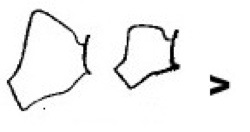 Petiole with
anterior face and dorsum meeting at an angle Petiole with
anterior face and dorsum meeting at an angle |
albicans-group
- 4 |
| -- |
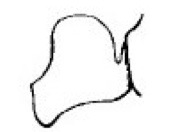 Petiole
wholly domed; TL of majors more than 9 mm Petiole
wholly domed; TL of majors more than 9 mm |
bicolor-group
- 8 |
| -- |
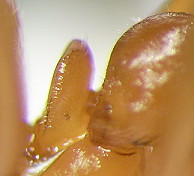 Petiole
squamiform - dimorphic,
major (if known) with long falciform mandibles Petiole
squamiform - dimorphic,
major (if known) with long falciform mandibles |
bombycinus &
emmae-groups - 2 |
| -- |
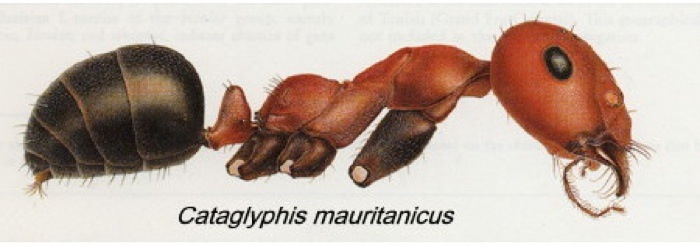 Petiole
high and angular; TL 9-13 mm; head noticeably longer than wide; head
& alitrunk dull, major partly dark (has been described as brightly
orange or yellow, gaster opaque, black, as in the drawing) Petiole
high and angular; TL 9-13 mm; head noticeably longer than wide; head
& alitrunk dull, major partly dark (has been described as brightly
orange or yellow, gaster opaque, black, as in the drawing)
|
. |
| . |
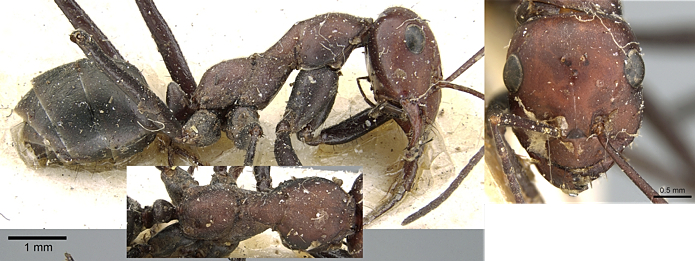 Major worker Major worker |
. |
| . |
 Type minor worker Type minor worker |
probably
not in sub-Saharan Africa - mauritanicus |
| . |
Petiole
scale squamiform - workers usually dimorphic
|
. |
| 2 |
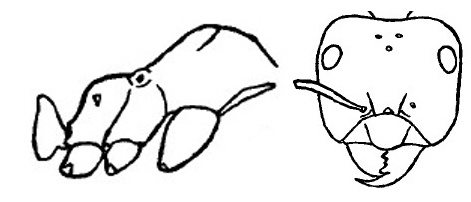 TL 3.0-5.5 mm; unicolorous
dull
brown-black, with allometric almost dimorphic workers TL 3.0-5.5 mm; unicolorous
dull
brown-black, with allometric almost dimorphic workers
|
. |
| . |
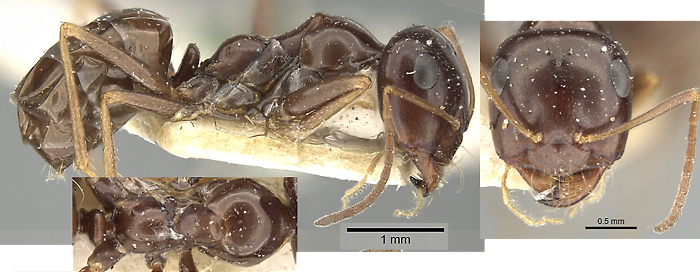 Media
worker Media
worker |
South
of the Atlas Mountains in North Africa - emmae-group - emmae |
| -- |
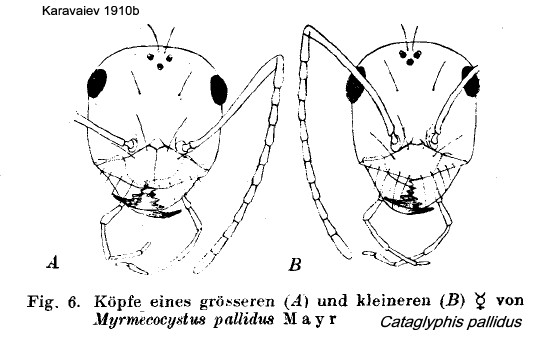 TL 3.5-4.5 mm; mandible with five teeth,
sometimes with extra denticles; if falcate then denticles always
indicated; gaster with sparse pubescence; body chestnut-brown or
yellow, borders of gaster brownish, shining - the pallidus type
location is Turkestan and the single Egypt record seems more
likely to be sabulosus or the minor of bombycinus. TL 3.5-4.5 mm; mandible with five teeth,
sometimes with extra denticles; if falcate then denticles always
indicated; gaster with sparse pubescence; body chestnut-brown or
yellow, borders of gaster brownish, shining - the pallidus type
location is Turkestan and the single Egypt record seems more
likely to be sabulosus or the minor of bombycinus. |
. |
| . |
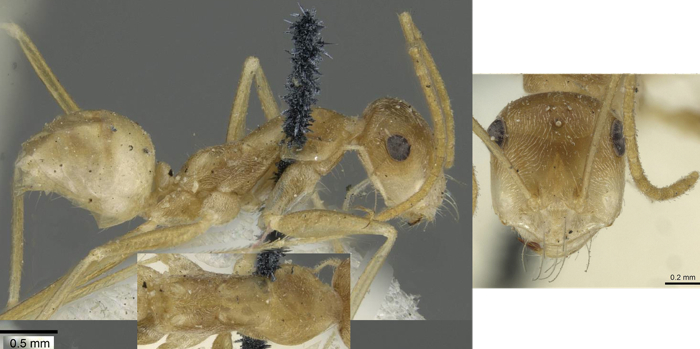 |
pallidus-group
- pallidus |
| -- |
Colour mainly yellow or
yellow-brown with a darker gaster |
bombycinus-group
- 3 |
| . |
bombycinus-group
|
. |
| 3 |
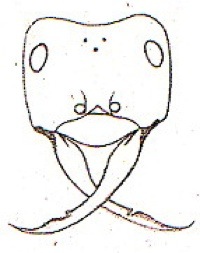 Dimorphic,
major TL 15 mm, minors TL 5.5-8.0 mm, soldier with falciform mandibles,
with a cleft posterior to the apical tooth; erect hairs on maxillary
palp segment 3 at least as long as half the segment; gaster brown
(separation according to Kugler, 1981). Note - the range of size in
"minor" workers and the differing forms of the mandibles, are
suggestive of polymorphism Dimorphic,
major TL 15 mm, minors TL 5.5-8.0 mm, soldier with falciform mandibles,
with a cleft posterior to the apical tooth; erect hairs on maxillary
palp segment 3 at least as long as half the segment; gaster brown
(separation according to Kugler, 1981). Note - the range of size in
"minor" workers and the differing forms of the mandibles, are
suggestive of polymorphism |
. |
| -- |
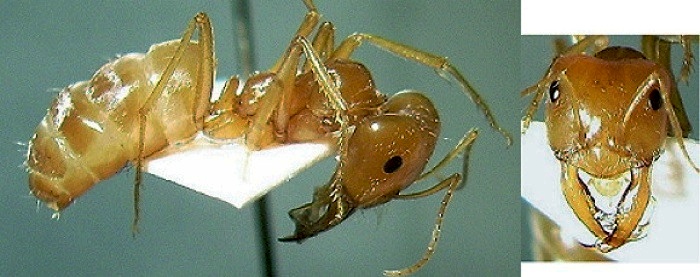 Major Major |
. |
| . |
 Media-minor Media-minor |
Libya
east to Egypt; Sudan & Mali - bombycinus |
| -- |
 Workers
only with variable size, TL 3-6 mm, but no major (although one may now
be known);
erect hairs on maxillary palp segment 3 between one-third and half as
long as the segment; gaster never more than light brown Workers
only with variable size, TL 3-6 mm, but no major (although one may now
be known);
erect hairs on maxillary palp segment 3 between one-third and half as
long as the segment; gaster never more than light brown |
. |
| . |
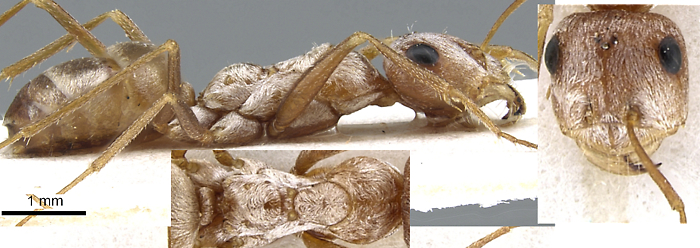 |
southern Israel &
northern Sinai - sabulosus |
| -- |
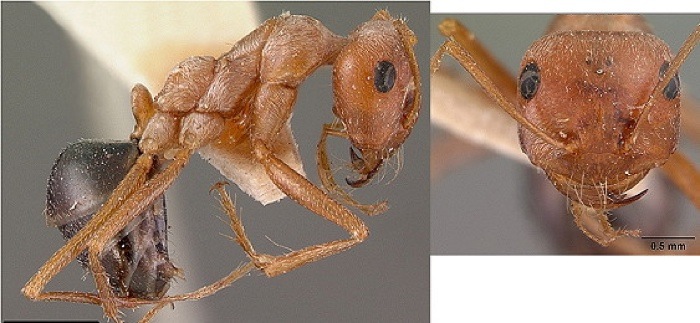 Purported
major (only form described) TL 5.0 mm; in size and form almost
identical to a media of bombycinus, gaster darker and lacking
pubescence so appears shiny Purported
major (only form described) TL 5.0 mm; in size and form almost
identical to a media of bombycinus, gaster darker and lacking
pubescence so appears shiny |
Tunisia
& Algeria - lucasi |
| -- |
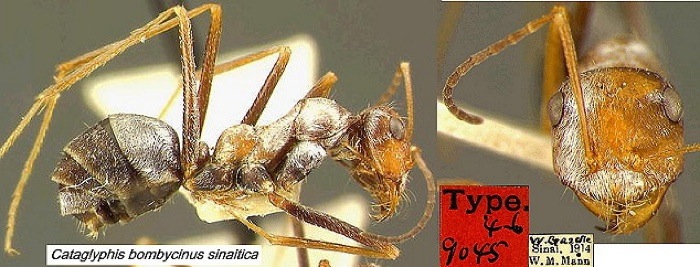 Workers
only with variable size but no known major; propodeum with domed
profile; gaster dark brown under whitish pubescence Workers
only with variable size but no known major; propodeum with domed
profile; gaster dark brown under whitish pubescence |
southern Israel &
northern Sinai - sinaiticus |
| -- |
From the short original description this
may well be the senior synonym of sinaiticus |
Egypt and/or Ethiopia - argentatus |
|
albicans-group |
. |
| 4 |
Not wholly dark |
5 |
| -- |
 TL 6-9 mm; overall
shiny black; larger HW 1.92 ± 0.02 mm, range 1.25-2.45; third segment
of maxillary palp longer than fourth; petiole profile more rounded;
legs much longer, hind femur 1.72 X AL (Wehner, 1983) TL 6-9 mm; overall
shiny black; larger HW 1.92 ± 0.02 mm, range 1.25-2.45; third segment
of maxillary palp longer than fourth; petiole profile more rounded;
legs much longer, hind femur 1.72 X AL (Wehner, 1983)
|
. |
| . |
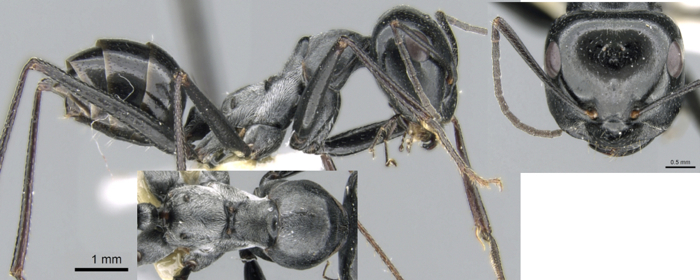 |
North Africa - fortis |
| -- |
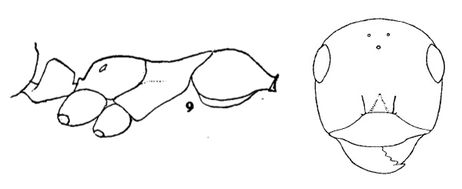 Smaller HW 1.25
± 0.02 mm, range 0.75-1.75; third segment of maxillary palp equal to
fourth; legs with hind femur 1.39 X AL; albicans from the same
collecting area as fortis had
the head light red-brown, pro- and mesonotum darker
red-brown,; antennae, tibiae and tarsi red-brown to lighter (Wehner,
1983) Smaller HW 1.25
± 0.02 mm, range 0.75-1.75; third segment of maxillary palp equal to
fourth; legs with hind femur 1.39 X AL; albicans from the same
collecting area as fortis had
the head light red-brown, pro- and mesonotum darker
red-brown,; antennae, tibiae and tarsi red-brown to lighter (Wehner,
1983)
TL 3.75-8.0 mm;
colour debateable - uniform shiny black (?)/ piceous-brown; HW of
largest
worker < 2 mm; petiole node with flat slope
height to length 4.5 : 4
Santschi (1929b key) - head shiny = albicans
ss and valbicans vaucheri
head dull = st. iberica
(Spain), v. opaca (Tunisia,
Algeria)
head semi-shiny (?) = st. odini
(Morocco)
|
.
|
| . |
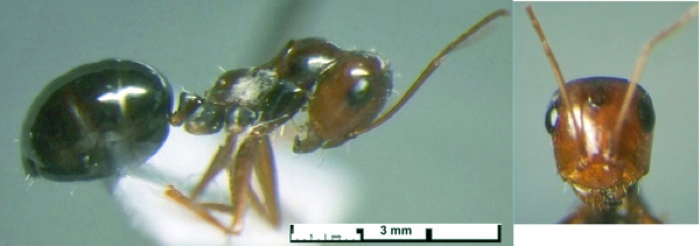 Major worker from
Egypt;
colours match the Wehner notes Major worker from
Egypt;
colours match the Wehner notes |
North
Africa - albicans |
| 5 |
Gaster darker than rest
of body; black or nearly so |
6
|
| -- |
Gaster not darker than head and alitrunk
or only moderately
|
7 |
| 6 |
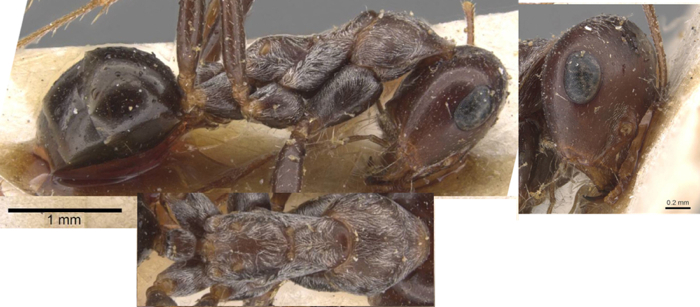 Type TL ca 5.3 mm; head red or reddish,
gaster piceous, submetallic; head shiny, alitrunk and petiole
subopaque;
alitrunk clothed in thick long pubescence, gaster dull (Collingwood,
1978: 92); pronotum almost glabrous = v. semitonsa Type TL ca 5.3 mm; head red or reddish,
gaster piceous, submetallic; head shiny, alitrunk and petiole
subopaque;
alitrunk clothed in thick long pubescence, gaster dull (Collingwood,
1978: 92); pronotum almost glabrous = v. semitonsa
|
North
Africa (Morocco) - cana |
| -- |
 TL
5.5-6 mm; bicoloured,
head and alitrunk yellow-red,
gaster shiny black; head in full face view with weakly convex occiput TL
5.5-6 mm; bicoloured,
head and alitrunk yellow-red,
gaster shiny black; head in full face view with weakly convex occiput
|
Ethiopia & Egypt
(Sinai) - franchettii
- new status |
| 7 |
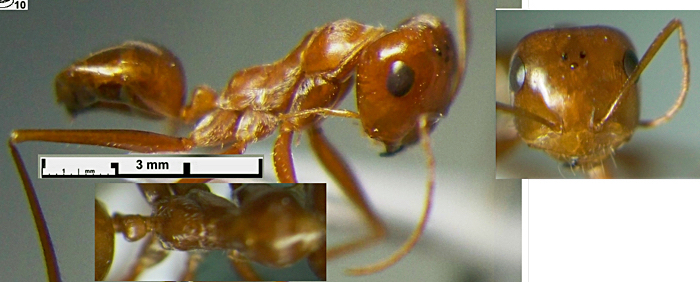 Major
TL ca 8 mm; golden brown in colour; the head and alitrunk have fine
reticulate sculpture; decumbent pubescence is well developed on the
occiput and on the dorsum and sides of the propodeum; the gaster is
brilliant with nohairs or pubescence; propodeum profile with near right angle between
dorsum and declivity; propodeum without obvious short erect hairs Major
TL ca 8 mm; golden brown in colour; the head and alitrunk have fine
reticulate sculpture; decumbent pubescence is well developed on the
occiput and on the dorsum and sides of the propodeum; the gaster is
brilliant with nohairs or pubescence; propodeum profile with near right angle between
dorsum and declivity; propodeum without obvious short erect hairs
|
Sudan,
Egypt, Saudi Arabia - auratus |
| -- |
 TL
5.5-6 mm; wholly yellow-orange;
propodeum profile with rounded obtuse
angle between dorsum and declivity; propodeum with obvious short erect
hairs (v. mixta and lutea) TL
5.5-6 mm; wholly yellow-orange;
propodeum profile with rounded obtuse
angle between dorsum and declivity; propodeum with obvious short erect
hairs (v. mixta and lutea)
|
Ethiopia & Egypt
(Sinai) - lividus
- new status |
--
|
 TL 4.8-7.0; bright orange with darker gaster; the head and alitrunk
semi-matt with fine
reticulate sculpture; with no obvious pubescence on the occiput or the propodeum;
the gaster semi-shiny with no hairs or pubescence; propodeum profile with evenly rounded angle
between
dorsum and declivity; propodeum with few perhaps only one pair of short
erect hairs TL 4.8-7.0; bright orange with darker gaster; the head and alitrunk
semi-matt with fine
reticulate sculpture; with no obvious pubescence on the occiput or the propodeum;
the gaster semi-shiny with no hairs or pubescence; propodeum profile with evenly rounded angle
between
dorsum and declivity; propodeum with few perhaps only one pair of short
erect hairs
|
North
Africa east to Kuwait - ruber |
| . |
bicolor-group |
. |
| 8 |
Head
distinctly wider than
long |
diehlii-complex - adenensis, diehlii
and isis - 9 |
|
Head not wider than long |
10
|
.
|
diehlii
complex with head distinctly wider than long
|
. |
| 9 |
 TL 6-8 mm; gaster dark contrasting
with red head (Kuwait specimen perhaps darker than the type); HL approx
= HW;
petiole dorsum mildly flattened; petiole squamiform TL 6-8 mm; gaster dark contrasting
with red head (Kuwait specimen perhaps darker than the type); HL approx
= HW;
petiole dorsum mildly flattened; petiole squamiform |
Egypt,
Kuwait
& Yemen - adenensis |
| -- |
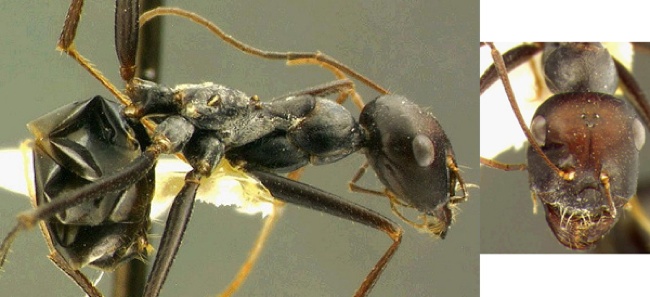 TL range 5.0-9.2 mm; gaster
smooth and shiny; Collingwood (1985: 287) noted - "This shining black
ant is also distinctive in having the funiculus segments shorter than
in C. bicolor or C. niger and allied species. The first
funiculus segment is about x 1.3 as long as the second compared with
about 1.8 x as long in the C. bicolor group and on this
character alone apart from the colour difference, cannot be regarded as
a subspecies of C. bicolor". Forel had noted, weakly
polymorphic; majors with relatively small heads
(cf viaticus & bicolor); propodeum and petiole
scale with greyish pubescence; entirely black except sometimes majors
with slightly red heads. TL range 5.0-9.2 mm; gaster
smooth and shiny; Collingwood (1985: 287) noted - "This shining black
ant is also distinctive in having the funiculus segments shorter than
in C. bicolor or C. niger and allied species. The first
funiculus segment is about x 1.3 as long as the second compared with
about 1.8 x as long in the C. bicolor group and on this
character alone apart from the colour difference, cannot be regarded as
a subspecies of C. bicolor". Forel had noted, weakly
polymorphic; majors with relatively small heads
(cf viaticus & bicolor); propodeum and petiole
scale with greyish pubescence; entirely black except sometimes majors
with slightly red heads. |
North Africa - diehlii |
| -- |
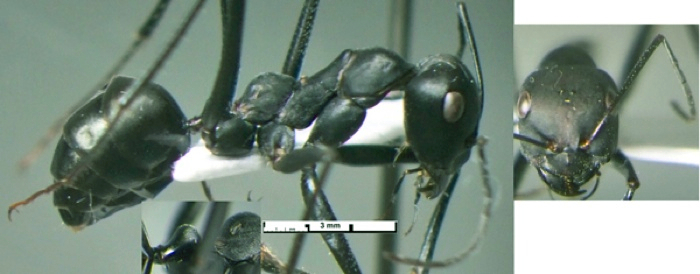 TL not
exceeding 9.5 mm; gaster mildly sculptured
and dull; scape with occasional erect hairs; body evenly dark,
mandibles reddish; differs from diehlii in having a strongly
pubescent alitrunk and occasional erect hairs on the scapes. . TL not
exceeding 9.5 mm; gaster mildly sculptured
and dull; scape with occasional erect hairs; body evenly dark,
mandibles reddish; differs from diehlii in having a strongly
pubescent alitrunk and occasional erect hairs on the scapes. . |
Egypt -
isis |
| -- |
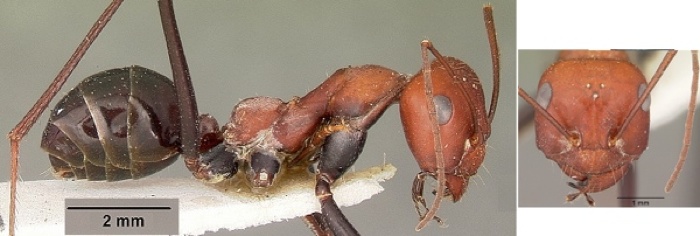 TL 8-9.5 mm; petiole dorsum smoothly
rounded; HL > HW; more distinctively bicoloured than the related
species TL 8-9.5 mm; petiole dorsum smoothly
rounded; HL > HW; more distinctively bicoloured than the related
species
|
North Africa - laevior |
| . |
bicolor
complex with head distinctly narrower than long
|
. |
| 10 |
  TL 8.0-12.5 mm; petiole with a low
dome, distinctly longer than wide; overall smaller and
most of head and body somewhat shinier,
with reduced sculpturation; gaster by contrast is less shiny than bicolor
with a heavier sculpture that matches the rest of the body TL 8.0-12.5 mm; petiole with a low
dome, distinctly longer than wide; overall smaller and
most of head and body somewhat shinier,
with reduced sculpturation; gaster by contrast is less shiny than bicolor
with a heavier sculpture that matches the rest of the body |
Ethiopia
- abyssinicus complex - abyssinicus |
| -- |
Petiole relatively short |
11 |
| . |
Petiole
relatively short |
. |
| 11 |
Petiole moderately high
and angular |
probably
not in sub-Saharan Africa - viaticus-group - 12 |
| -- |
 Petiole node
smoothly domed; maxillary palps long, segment
4 longer than 5+6 Petiole node
smoothly domed; maxillary palps long, segment
4 longer than 5+6 |
bicolor-complex 13 |
| 12 |
 TL 9-13 mm; petiole moderately
high and angular; head
noticeably
longer than wide; head & alitrunk brightly orange or yellow, gaster
opaque, brown to black TL 9-13 mm; petiole moderately
high and angular; head
noticeably
longer than wide; head & alitrunk brightly orange or yellow, gaster
opaque, brown to black |
Spain,
Morocco viaticus |
| -- |
 TL 7-10 mm; petiole with a low weakly angular face; red darker than
the
type bicolor, appendages and gaster matt black; occipitum,
lower head and gaster and legs somewhat shiny; sides of alitrunk and
femora pubescent; lower head, thorax and gaster pilous; upper body
glabrous TL 7-10 mm; petiole with a low weakly angular face; red darker than
the
type bicolor, appendages and gaster matt black; occipitum,
lower head and gaster and legs somewhat shiny; sides of alitrunk and
femora pubescent; lower head, thorax and gaster pilous; upper body
glabrous |
Egypt - savignyi |
| -- |
 TL 7-13 mm; petiole relatively
short TL 7-13 mm; petiole relatively
short |
from South Asia (reported
wrongly from Ghana)
- setipes |
| . |
bicolor
complex - all with the petiole node a moderately high dome
|
. |
| 13 |
 Tl (major?) ca 12 mm; petiole
node with
low flat dome with a vertical anterior face; red a
little darker than the type bicolor (although less so than desertorum),
appendages as the body; gaster matt black; occipitum, lower head and
gaster and legs somewhat shiny; sides of alitrunk and femora pubescent;
lower head, thorax and gaster pilous; upper body glabrous Tl (major?) ca 12 mm; petiole
node with
low flat dome with a vertical anterior face; red a
little darker than the type bicolor (although less so than desertorum),
appendages as the body; gaster matt black; occipitum, lower head and
gaster and legs somewhat shiny; sides of alitrunk and femora pubescent;
lower head, thorax and gaster pilous; upper body glabrous |
West
Africa and Congo
Sahel zone - congolensis |
| -- |
 Petiole node
smoothly domed; petiole as
high as long; maxillary palps long, segment 4 longer than 5+6 Petiole node
smoothly domed; petiole as
high as long; maxillary palps long, segment 4 longer than 5+6 |
bicolor-complex
- 14 |
| 14 |
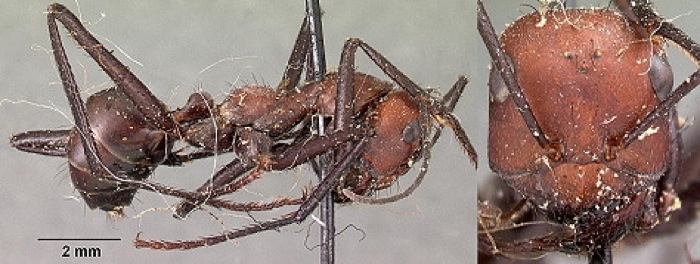 TL (type ca 12.5 mm); whole
of body and legs with coarse dark erect hairs or setae; major head
widest anteriorly TL (type ca 12.5 mm); whole
of body and legs with coarse dark erect hairs or setae; major head
widest anteriorly |
coastal
arid areas in Ghana & Ivory Coast - seticornis |
| -- |
Erect hairs numerous but quite short and
fine; major head not widest anteriorly |
15 |
| 15 |
Body overall uniformly
dark
black to blackish red |
16 |
| -- |
Body bicoloured |
17 |
| 16 |
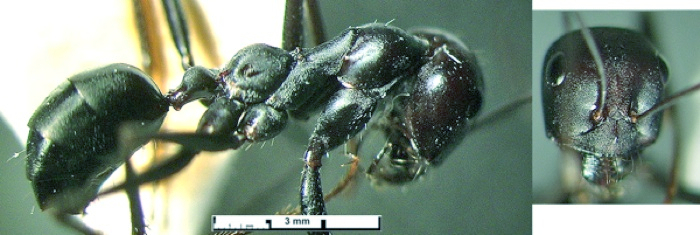 TL 9-12 mm; body overall uniformly dark
black but head often blackish red; propodeum with rounded transition
from dorsum to declivity TL 9-12 mm; body overall uniformly dark
black but head often blackish red; propodeum with rounded transition
from dorsum to declivity
|
Ethiopia
& Sudan - niger |
| -- |
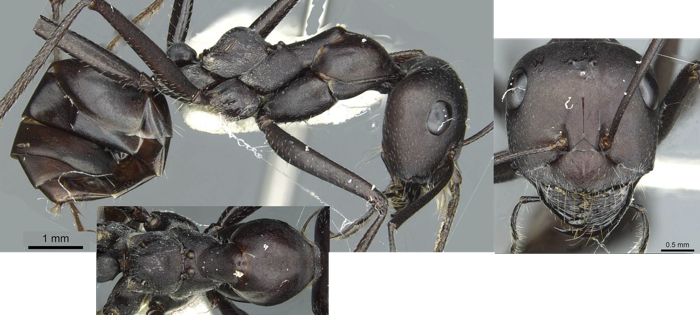 TL ca 12 mm; body uniformly dark black; more angular transition from
dorsum to declivity of highly raised propodeum; TL ca 12 mm; body uniformly dark black; more angular transition from
dorsum to declivity of highly raised propodeum;
|
Egypt and Saudi Arabia - holgerseni |
| 17 |
Strongly bicoloured |
18 |
| -- |
Only weakly bicoloured |
19 |
| 18 |
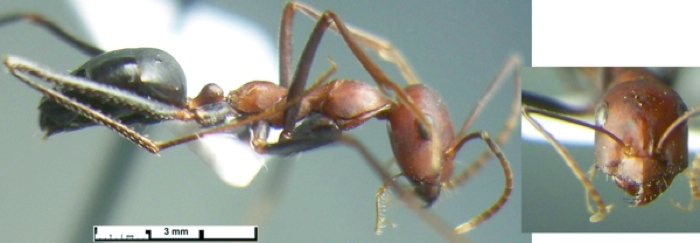 TL 6-10 mm; petiole
profile slightly angled forward and with vertical faces below a
relatively narrow dome; short erect hairs on all dorsal surfaces;
pronotum with very weak pubescence, quite abundant on sides of
propodeum and legs; major worker with legs red as with the body,
brownish in smaller workers TL 6-10 mm; petiole
profile slightly angled forward and with vertical faces below a
relatively narrow dome; short erect hairs on all dorsal surfaces;
pronotum with very weak pubescence, quite abundant on sides of
propodeum and legs; major worker with legs red as with the body,
brownish in smaller workers |
Ethiopia
& Sudan - bicolor |
| -- |
 TL 7-12 mm; more
robust with relatively short legs; profile of promesonotum and
propodeum only shallowly convex; petiole perhaps a little higher;
mandibles very coarsely striated; hind tarsi with dense coarse
adpressed pubescence; matt except for occipitum; relatively weakly
bicolour, very dark red, scape darker than rest of head, appendages
brown red TL 7-12 mm; more
robust with relatively short legs; profile of promesonotum and
propodeum only shallowly convex; petiole perhaps a little higher;
mandibles very coarsely striated; hind tarsi with dense coarse
adpressed pubescence; matt except for occipitum; relatively weakly
bicolour, very dark red, scape darker than rest of head, appendages
brown red |
Ethiopia - desertorum |
| 19 |
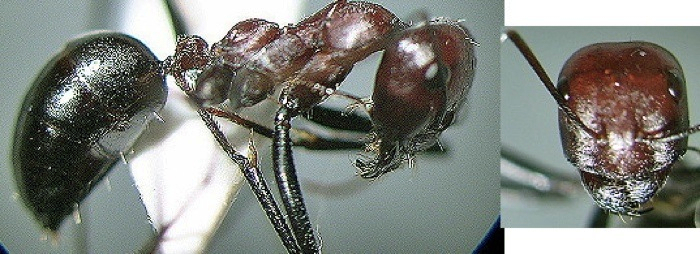 TL 8-11 mm; petiole profile a
near perfect dome; erect hairs very
short, whitish or colourless, and confined to a few on the vertex and
occiput, less on the pronotum and two pairs on the petiole, there are
none on the propodeum or dorsum of the gaster; the pubescence is very
sparse and minute; overall relatively more coarsely sculptured but
glossier than bicolor; appendages dark mostly black in all
workers TL 8-11 mm; petiole profile a
near perfect dome; erect hairs very
short, whitish or colourless, and confined to a few on the vertex and
occiput, less on the pronotum and two pairs on the petiole, there are
none on the propodeum or dorsum of the gaster; the pubescence is very
sparse and minute; overall relatively more coarsely sculptured but
glossier than bicolor; appendages dark mostly black in all
workers |
Morocco, Algeria & western Sahel - saharae |
| -- |
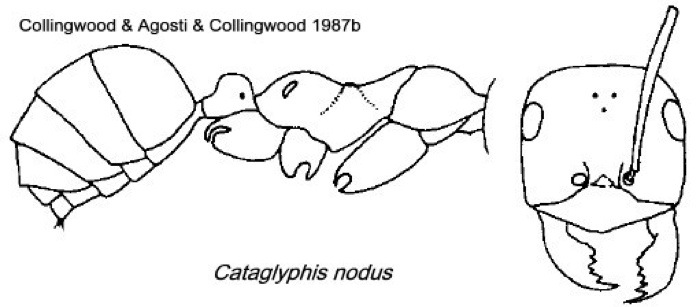 TL 5.0-12.7 mm; petiole
node not angled forward; and node lowest dome of group, relatively
square; fine close short pubescence on the tibiae and
tarsi; no erect hairs on the scapes; colour always clear red, darker on
the largest workers, gaster black; the identifications from
Egypt seem likely to have been wrong TL 5.0-12.7 mm; petiole
node not angled forward; and node lowest dome of group, relatively
square; fine close short pubescence on the tibiae and
tarsi; no erect hairs on the scapes; colour always clear red, darker on
the largest workers, gaster black; the identifications from
Egypt seem likely to have been wrong |
nodus complex -
eastern
Europe into west Asia - nodus |
| -- |
 TL (major) 12 mm plus; ptiole
profile slightly angled forward and with vertical faces below a
relatively narrow dome; short erect hairs on all dorsal surfaces;
pronotum with very weak pubescence, quite abundant on sides of
propodeum and legs; workers with legs black; eyes in most if not all
red-brown; hairs on anterior of clypeus and mandibles yellow TL (major) 12 mm plus; ptiole
profile slightly angled forward and with vertical faces below a
relatively narrow dome; short erect hairs on all dorsal surfaces;
pronotum with very weak pubescence, quite abundant on sides of
propodeum and legs; workers with legs black; eyes in most if not all
red-brown; hairs on anterior of clypeus and mandibles yellow
|
North
Africa & Gambia - oasium |